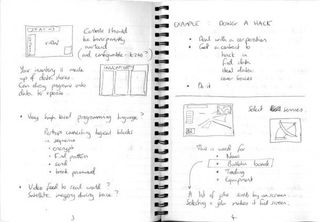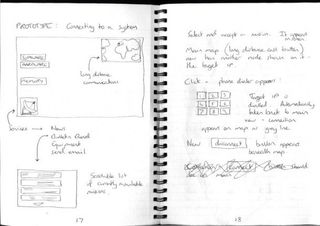
This article originally appeared in issue 247 of PC Gamer UK.
As a game designer and co-founder of Introversion, Chris Delay is a respected, successful indie developer. He and his partners, Mark Morris and Tom Arundel, won the grand prize at the Independent Games Festival for their virus-infected strategy game, Darwinia. They've haunted a thousand multiplayer servers with the spectre of global thermonuclear war in Defcon. They've also established themselves as a cornerstone of the independent developer community.
But before all that, there was just Chris and an idea.
“By the end of sixth form I had the idea for the game. It was going to be like Frontier Elite 2, in which you fly a spaceship around and visit starports and upgrade. I wanted to do that, but in the online world.” He called the idea Uplink.
When it was released, Uplink was an austere, menu-driven hacking simulator, where players navigated electric blue interfaces to manipulate mainframes, race against progress bars and escape without trace. It took place in a murky, cyberpunk world where the act of electronic pilfering was fast and panicked, sleek and cool. A world viewed through a computer screen within a computer screen, where the player was always seconds from detection.
How did Uplink get from that Tron-like idea of flying inside your computer to a slick vision of hacking?

The first problem was that real-life hacking is boring. Really boring. Chris explains: “The first thing you'll probably do is a port scan on a device. You scan every single open port. It'll probably have a hundred open ports; you need to look at every one. It could be hours of work to get there and it might not even work. Even I can't be arsed with command prompts.”
The biggest gaming news, reviews and hardware deals
Keep up to date with the most important stories and the best deals, as picked by the PC Gamer team.
Uplink was inspired by classic '80s movies like WarGames, where Matthew Broderick cracked into government computers with a tape deck and a few typed command lines. Whatever the game was going to be, it had to be similarly streamlined. Even when removed from the dull slog of real hacking, Chris was sceptical that his game would ever be commercially viable.
“I wasn't even planning on releasing it publicly,” he admits. “It seemed that the subject matter, lack of 3D graphics, and dominance of the big-name publishers would make this game impossible to sell.” This was in 2001, a short while before indie game development became popular, or minimalism was an accepted game design choice. Given that it's the simple, 2D menus that keep Uplink timeless today, we're lucky it turned out that way.
Early in development, Chris's hacker vision was clouded by a slightly more modern movie. He was drawn to the futuristic world depicted in 1995 cyberpunk action flick Johnny Mnemonic.
In fact, his concept for Uplink was cluttered with misguided influences: “You would be able to enter your own computer and see the CPU as a soaring skyscraper, and you would routinely be attacked by a virus that you would have to destroy. Target computer systems looked like small cities. The game originally looked more like a surreal flight simulator than anything else.”

It set development off in the wrong direction, and it took two months before he jettisoned the idea of a 3D world. “I think 2D's brilliant. I love 2D to death,” Chris says with the benefit of hindsight. Far from discouraged, though, the setback made him focus more. He grabbed a notebook and started writing down every idea he had for Uplink.
“Once you're two years into the project, that's when you realise you have to write things down at the start, because you forget what the point of the game was. Being able to open up the original book and figure out what it was that excited you in the first place is a great guideline, a really good touchstone.”
Chris calls these touchstones his bibles, and it's a fitting name. The notebook pages you can see in this feature are an uncannily accurate representation of the final game. They aren't a set of notes, they're synoptic gospels. There were three of them in total, used to store Chris's ideas before they evaporated. He'd jot them down in university lectures, or moments of inspiration. “It was probably 12 months before what you see on those pages ended up on screen,” he says. As a kind of tribute to their importance, Chris even made the books available in-game, on a secret server.
Even though 3D graphics had been scrapped, Uplink was still vulnerable to feature creep. At one point, Chris had the player organically linked to his computer, cyberpunk style: “You were totally immobile but you could install security such as cameras and laser trip wires to defend yourself. You had a couple of helper robots under your control, which could run around your room performing maintenance on all your hardware.”
The original Revelation Virus, which still features in Uplink in a different form, would trap hackers, keeping them fixed to their CPUs and starving them over time.
Most Popular

